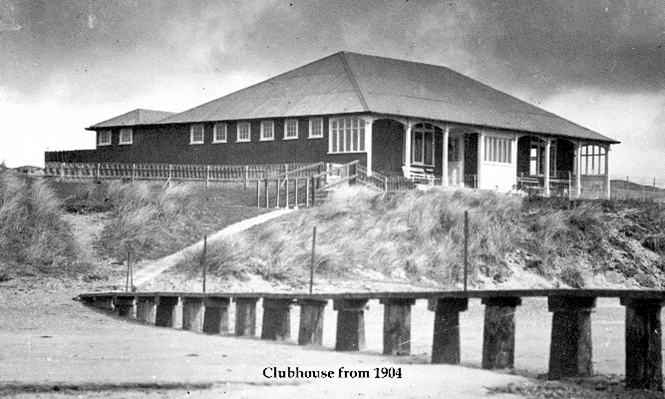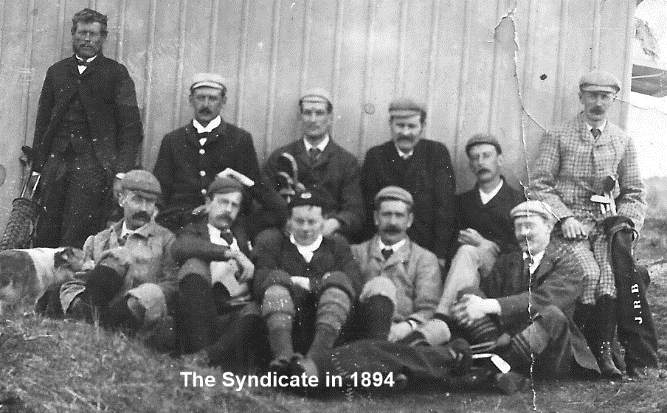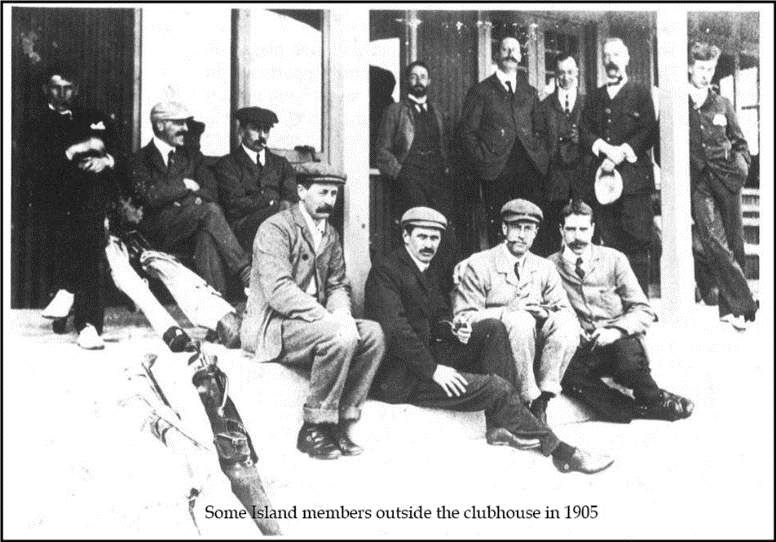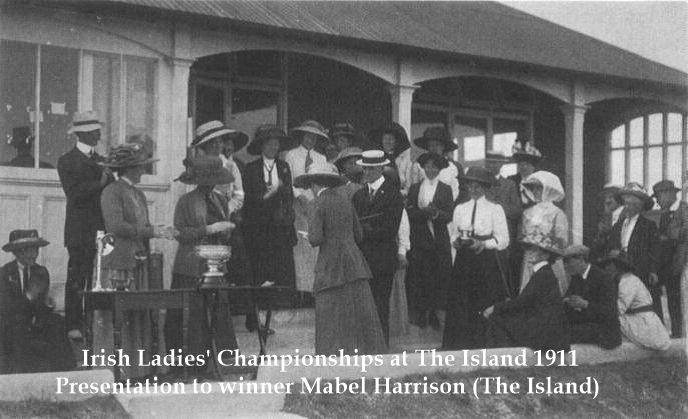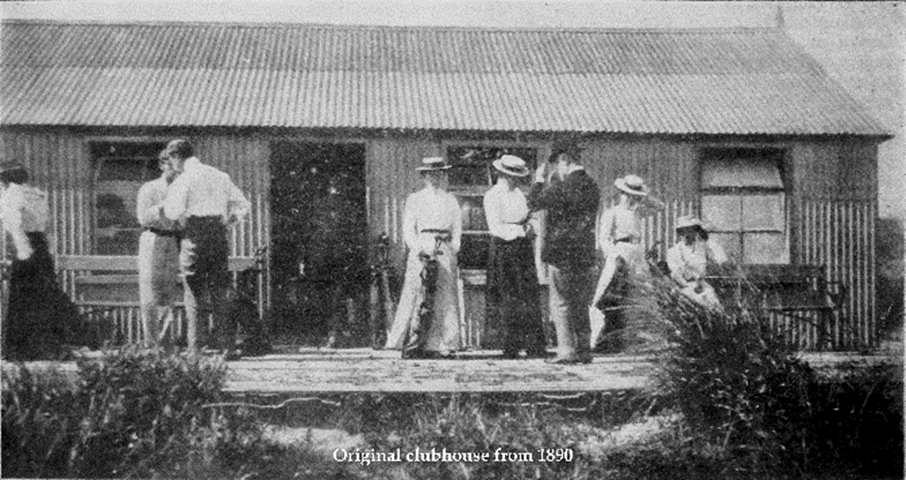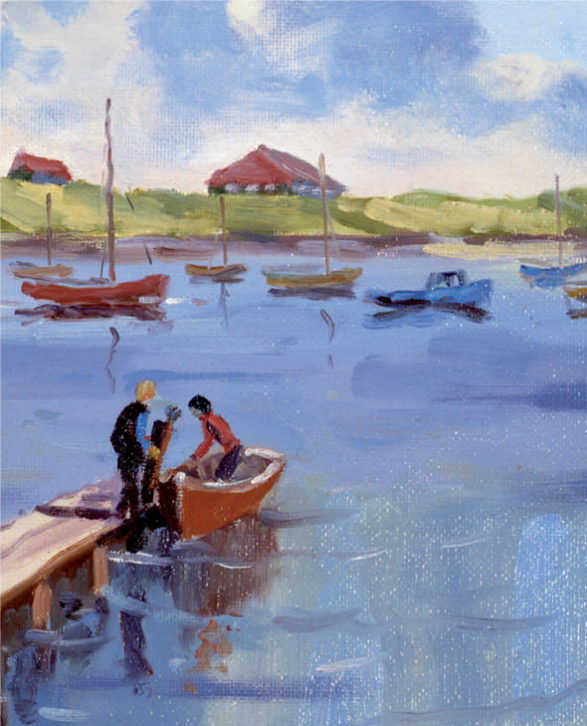A Brief History of The Island Golf Club
The Island Golf Club is recognised as being founded in 1890 but recent research indicates that 1888 or 1889 might be more accurate. Comdt. William Gibson, in his landmark book on the history of golf in Ireland, records that there were just seven clubs in existence in 1889: four in Leinster and three in Ulster. The Island and four others were founded in 1890, but of those twelve clubs only seven still exist today.
The club was unusual in that it had no military connection and was founded as a private club for the benefit of the members and their families. The ten founder members, known as the ‘Syndicate’, only permitted others to join the club on an annual basis as annual ticket holders. Over time, the term ‘ticket holder’ changed to ‘associate member’.
Most of the members of the Syndicate were already members of The Dublin Golf Club (later The Royal Dublin GC) which was founded in 1885. However, while The Dublin GC was seeking a more suitable location for its course than the Phoenix Park, a number of their members investigated the potential of Malahide, Co. Dublin.
“In September 1887 four men rowed across the channel which separates the North Dublin village of Malahide from the spur of land to the north known locally as the Island. Their mission was to survey the wilderness and assess its suitably as a golf links.”
This visionary boat journey is thus described in the first hand-written account of The Island’s history by John Horish, a farmer who lived in the house at the entrance to the club and whose father did most of the work preparing the course.
Once the Syndicate had negotiated a lease of the land with the Cobbe family of Newbridge House, Michael Horish, a local farmer, was engaged to cut the fairways and greens with a scythe in preparation for a mowing machine. It is not known who was responsible for the design of the original course, comprising eighteen individual holes, but it was imaginative in how it followed the valleys between the many sand dunes while following the paths of least resistance. The course has been altered several times since that time to become one of the finest championship links in the country but has retained the basic character of a links amid beautiful sand dunes.
The club was unusual in that it had no military connection and was founded as a private club for the benefit of the members and their families. The ten founder members, known as the ‘Syndicate’, only permitted others to join the club on an annual basis as annual ticket holders. Over time, the term ‘ticket holder’ changed to ‘associate member’.
Most of the members of the Syndicate were already members of The Dublin Golf Club (later The Royal Dublin GC) which was founded in 1885. However, while The Dublin GC was seeking a more suitable location for its course than the Phoenix Park, a number of their members investigated the potential of Malahide, Co. Dublin.
“In September 1887 four men rowed across the channel which separates the North Dublin village of Malahide from the spur of land to the north known locally as the Island. Their mission was to survey the wilderness and assess its suitably as a golf links.”
This visionary boat journey is thus described in the first hand-written account of The Island’s history by John Horish, a farmer who lived in the house at the entrance to the club and whose father did most of the work preparing the course.
Once the Syndicate had negotiated a lease of the land with the Cobbe family of Newbridge House, Michael Horish, a local farmer, was engaged to cut the fairways and greens with a scythe in preparation for a mowing machine. It is not known who was responsible for the design of the original course, comprising eighteen individual holes, but it was imaginative in how it followed the valleys between the many sand dunes while following the paths of least resistance. The course has been altered several times since that time to become one of the finest championship links in the country but has retained the basic character of a links amid beautiful sand dunes.
The Founders or the Syndicate
The founder members numbered ten in total and were collectively known as the ‘Syndicate’. They were John Redmond Blood, David Francis Moore, James J. Law, James Rippingham Bristow, Henry J. Daly, William Samuel Hayes, James Henry Barrington, Godfrey Ferguson, Thomas Stewart and Daniel Martin Wilson.
Law, Bristow and Ferguson were from Belfast and came to Dublin to work for the Northern Bank, Bristow later becoming its chairman. Stewart hailed from Derry and was a barrister. Wilson, born in Limerick, was also a barrister; he was later to become Chief Justice and stood for election to the Westminster Parliament. Daly was a solicitor and became High Sheriff for Co. Louth and later served as Hon. Secretary of the GUI. Moore and Hayes, both from Dublin, were solicitors. The only members with non-legal or non-banking backgrounds were Barrington, who had a large soap business in Dublin, and Blood, who owned Mountjoy Brewery in Russell Street, Dublin.
As time passed and members of the original Syndicate died, they were replaced by others. This continued until the modern era of the club was shaped in 1952 when the members of the Syndicate generously gifted its entire interest in the club to the associate members, who now became the new full members and owners of The Island Golf Club.
As time passed and members of the original Syndicate died, they were replaced by others. This continued until the modern era of the club was shaped in 1952 when the members of the Syndicate generously gifted its entire interest in the club to the associate members, who now became the new full members and owners of The Island Golf Club.
Golfing Activity
The club has a long association with the Golfing Union of Ireland and became affiliated after its foundation in 1891, and Henry J. Daly, a member of the original Syndicate, was the Honorary Secretary of the GUI from 1899 to 1905.However, the club was not an active participant in GUI inter-club competitions, preferring competition that had a stronger social element. The club frequently held friendly matches against other clubs and was well-known for its open mixed-foursomes’ competitions which were always popular.
This changed when the members took ownership of the club, and participation in all GUI activities and competition became the norm. Ultimate success in inter-club competition was achieved in 1967 when the club won the Senior Cup and again in 1983.The club has reached the final of the Senior Cup on many occasions and always manages to field a team that is a serious contender for the title.
This changed when the members took ownership of the club, and participation in all GUI activities and competition became the norm. Ultimate success in inter-club competition was achieved in 1967 when the club won the Senior Cup and again in 1983.The club has reached the final of the Senior Cup on many occasions and always manages to field a team that is a serious contender for the title.
Ladies’ Branch
The Ladies’ Branch of the club was very involved in the ILGU both in its administration and in its competitions. Until the time of Second World War, the Ladies’ Branch was a force to be reckoned with in both club matches and individual play.
Janet Townsend was Hon. Secretary of the Dublin Executive ILGU for ten years before taking on the same role for twenty years for the ILGU in 1926.
The great lady golfers of The Island were Mabel Harrison, Janet Jackson, Patricia Jameson, Sheelagh Jameson, and Pat Walker. Mabel Harrison won the Ladies’ Close Championship in 1910, 1911 and 1912, followed by Janet Jackson in 1913, 1914, 1919, 1920, 1923 and 1925. Janet Jackson’s successful run was only interrupted by the Great War and, following her last victory in 1925, Patricia Jameson won the title in 1926. Pat Walker was selected for every Irish team from 1928 to 1938 and she went on to become the first Irish player to be selected for the Curtis Cup in 1934. She won the Irish Close in 1930 while then a member of The Berkshire GC but her opponent in the final was another Island stalwart, Sheelagh Jameson (née Tobin).
The Ladies’ Branch won the Irish Senior Cup in 1928, 1929, and 2005. They were also the last club to hold the ILGU Challenge Cup, the precursor to the Senior Cup.
Janet Townsend was Hon. Secretary of the Dublin Executive ILGU for ten years before taking on the same role for twenty years for the ILGU in 1926.
The great lady golfers of The Island were Mabel Harrison, Janet Jackson, Patricia Jameson, Sheelagh Jameson, and Pat Walker. Mabel Harrison won the Ladies’ Close Championship in 1910, 1911 and 1912, followed by Janet Jackson in 1913, 1914, 1919, 1920, 1923 and 1925. Janet Jackson’s successful run was only interrupted by the Great War and, following her last victory in 1925, Patricia Jameson won the title in 1926. Pat Walker was selected for every Irish team from 1928 to 1938 and she went on to become the first Irish player to be selected for the Curtis Cup in 1934. She won the Irish Close in 1930 while then a member of The Berkshire GC but her opponent in the final was another Island stalwart, Sheelagh Jameson (née Tobin).
The Ladies’ Branch won the Irish Senior Cup in 1928, 1929, and 2005. They were also the last club to hold the ILGU Challenge Cup, the precursor to the Senior Cup.
Clubhouse
The original clubhouse, a quaint wood and corrugated-iron pavilion, was situated on a site overlooking the estuary at Malahide. For over 80 years, access to and from the course was by rowing boat from a slipway in Malahide. A second, more durable, pavilion was built in 1904 (also using wood and corrugated iron) and this served until the regular boat service to the club was discontinued in 1973 and a new clubhouse was built at the other end of the course at Corballis, making the club accessible by road. The present clubhouse dates from this time and is sufficiently well-appointed to host major amateur tournaments as well as meeting the needs of the members and the many visitors who come to enjoy the links.
The Boat
As its title suggests, the last leg of the journey to play golf at The Island was by boat and there are many stories about the boat, the boatmen, the order of embarkation and the priority thereof. When the boat took a party of golfers to The Island, they were entirely dependent on the boat for the return journey.
The signal to the boatman on the far side of the estuary to collect golfers from the links was to open a large red and white disc on the side of the pavilion. The disc was hinged in the centre and could be seen from the shore by the boatman. When the disc was in the closed position it was green in colour and blended in with the wall of the pavilion.
The signal to the boatman on the far side of the estuary to collect golfers from the links was to open a large red and white disc on the side of the pavilion. The disc was hinged in the centre and could be seen from the shore by the boatman. When the disc was in the closed position it was green in colour and blended in with the wall of the pavilion.
Bonar Law’s secret visit to The Island ends in tragedy
Andrew Bonar Law (1858 to 1923) was elected leader of the Conservative Unionist Party in England in 1911. The Canadian-born son of a Scottish Clergyman, he played a pivotal role in Lloyd George’s First World War cabinet and was elected Prime Minister in 1922.
Bonar Law’s connections with The Island first surfaced on Saturday, 17th May 1913, when he played the links accompanied by Lord Glenavy (J.H.Campbell MP), a member of the club and a close friend of the Blood family, who later served as Lord Chief Justice from 1916 to 1918.
Also, on the links that summer’s morning was Very Rev. Michael Webster, an associate club member who was Dean of The Chapel Royal in Dublin Castle, who was playing a match against the Hon. Secretary of the club, Mr J.R. Blood.
Law was in Dublin on a social visit and news of his presence in Dublin had been kept from the press. However, during the course of his match against Mr Blood, played in benign conditions over a much different links than today Dean Webster became ill. Despite efforts to revive him, he died on the eighth tee. Word spread quickly throughout the nearby village of Malahide that he had died on The Island and that Bonar Law and Lord Glenavy were also on the links. The Royal Irish Constabulary arrived at the scene and Webster’s remains were transported to Blood’s house at Ballykilty, Malahide.
The story was carried on the front page of The Irish Times the next day and there was great interest in Bonar Law’s visit. However, he insisted that he was in Ireland for a short holiday and he was playing The Island because he had so enjoyed the links on his previous visit two years earlier.
The legacy that Dean Webster left The Island was in the shape of a splendid silver trophy, presented in his memory by his wife shortly after his untimely death. Unfortunately, the original cup disappeared some years ago but it is still competed for, a keenly contested singles competition which signals the start of the men’s golfing season and serves as yet another reminder of the fascinating history of The Island Golf Club.
Bonar Law’s connections with The Island first surfaced on Saturday, 17th May 1913, when he played the links accompanied by Lord Glenavy (J.H.Campbell MP), a member of the club and a close friend of the Blood family, who later served as Lord Chief Justice from 1916 to 1918.
Also, on the links that summer’s morning was Very Rev. Michael Webster, an associate club member who was Dean of The Chapel Royal in Dublin Castle, who was playing a match against the Hon. Secretary of the club, Mr J.R. Blood.
Law was in Dublin on a social visit and news of his presence in Dublin had been kept from the press. However, during the course of his match against Mr Blood, played in benign conditions over a much different links than today Dean Webster became ill. Despite efforts to revive him, he died on the eighth tee. Word spread quickly throughout the nearby village of Malahide that he had died on The Island and that Bonar Law and Lord Glenavy were also on the links. The Royal Irish Constabulary arrived at the scene and Webster’s remains were transported to Blood’s house at Ballykilty, Malahide.
The story was carried on the front page of The Irish Times the next day and there was great interest in Bonar Law’s visit. However, he insisted that he was in Ireland for a short holiday and he was playing The Island because he had so enjoyed the links on his previous visit two years earlier.
The legacy that Dean Webster left The Island was in the shape of a splendid silver trophy, presented in his memory by his wife shortly after his untimely death. Unfortunately, the original cup disappeared some years ago but it is still competed for, a keenly contested singles competition which signals the start of the men’s golfing season and serves as yet another reminder of the fascinating history of The Island Golf Club.
Modern Times
Since the hand-over of the club to the members by the Syndicate, golfing at The Island has progressed through increasing membership numbers, entering inter-club competitions, redesigning the links, and the continuous improvement of club facilities.
The move to a new clubhouse in 1973 necessitated a complete re-orientation of the course. This was based on a design by Fred Hawtree, the renowned golf architect, and was implemented with modifications by Eddie Hackett. Further modifications were made by Fred’s son Martin some years later. The latest changes to the layout of the course were made Mackenzie & Ebert in 2019.
The club has hosted many championships over the years: the Irish Ladies’ Close Championship; the Irish Close Championship; the Irish PGA Championship; the European Youths’ Championships; the Irish Amateur Open Championship; The Open Amateur Championship (shared with Portmarnock GC), and has been a venue for several years as a qualifying venue for The Open Championship.
The move to a new clubhouse in 1973 necessitated a complete re-orientation of the course. This was based on a design by Fred Hawtree, the renowned golf architect, and was implemented with modifications by Eddie Hackett. Further modifications were made by Fred’s son Martin some years later. The latest changes to the layout of the course were made Mackenzie & Ebert in 2019.
The club has hosted many championships over the years: the Irish Ladies’ Close Championship; the Irish Close Championship; the Irish PGA Championship; the European Youths’ Championships; the Irish Amateur Open Championship; The Open Amateur Championship (shared with Portmarnock GC), and has been a venue for several years as a qualifying venue for The Open Championship.
